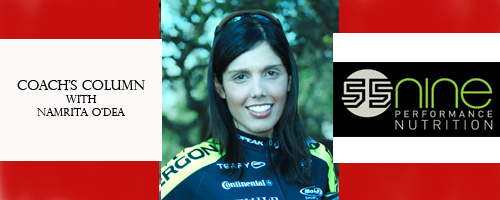
This week our question goes to Namrita O'Dea. A licensed dietician and member of the Topeak/Ergon racing team, O'Dea helps riders fine tune their bodies for maximum performance through her business 55 Nine Performance Nutrition.
Question: My body fat hovers around 10-12 percent and I would like to get it down a few points. What's a safe way to bring my body fat down without negatively impacting my winter training?
Namrita O'Dea: Winter is a good time to really focus on changing your body composition. Losing body fat while building fitness is a fine line to ride, though, and extra care should be taken to adequately fuel and recover from all training sessions. As you will read below, a multi-pronged approach will be most effective. A detailed training and a nutrition log, if you have time, are also very useful throughout the process.
DXA, hydrostatic weighing, and the Bod Pod are the more accurate methods of measuring body composition. However, if you only have skinfold or BIA, use them as relative measurements to gauge your progress. Just keep in mind, the error percentage is higher when using the latter methods. A regular weight scale won’t tell the whole story when you want to differentiate percent fat from lean mass.
In order to preserve your metabolism and lean body mass while losing fat, create a slight energy deficit of approximately 250 to 400 calories per day. You can do this by eating slightly less at your larger meals, eating more nutrient-dense rather than energy-dense foods, increasing the amount of fresh foods in your diet, and reducing extra calories such as those from salty snacks, desserts, sodas, or alcohol.
Protein will keep you satiated longer and, when consumed with carbohydrates, will help to slow the insulin response. Aim for just under 2 grams of protein per kilogram of your body weight, per day. When race season comes around, you can slightly decrease protein and increase your carbohydrate intake again.
Aim for around 20% of total calories from fat per day, with the majority of fat coming from unsaturated sources. Animal fats are higher in saturated fats and should be limited. If you can’t successfully moderate your dessert intake it is probably best to cut it out all together and substitute it with lower-calorie options. One square of dark chocolate can go a long way in satisfying a sweet craving!
As an athlete, carbohydrates should comprise at least 50% of your macronutrient intake. Because refined sugars are less satiating and cause more rapid insulin spikes, most of the carbohydrates should come from higher-fiber complex carbohydrates, fruits, and vegetables. When possible, combine carbohydrates with protein. Once higher intensity training and racing ramps up, you will want to increase the daily percentage of calories from carbohydrates to approximately 65% of total calories.
The timing of your energy intake is equally important as what you eat. Scale your energy intake so you are taking in more calories when you are more active (i.e. in the first half of the day versus right before bed). Don’t skip meals or snacks and try to go no more than 3 hours at a time without energy intake. Avoid consuming mass amounts of calories at one time, as is often done at a post-ride recovery meal.
Never skip the recovery drink or snack. Immediately after a training session, use a 250 to 400 calorie recovery drink (or equivalent food with additional fluid). Then consume smaller 250-600 calorie snacks or meals every 1-2 hours to maximize recovery and minimize excess fat storage.
Incorporate strength training into your regimen, if you have not already. Not only will it help your performance, it will help you reach your fat loss goals more quickly.
Finally, green tea catechins have shown some promise in fat metabolism. So, brewing some hot green tea might be a good way to keep warm in the winter!

